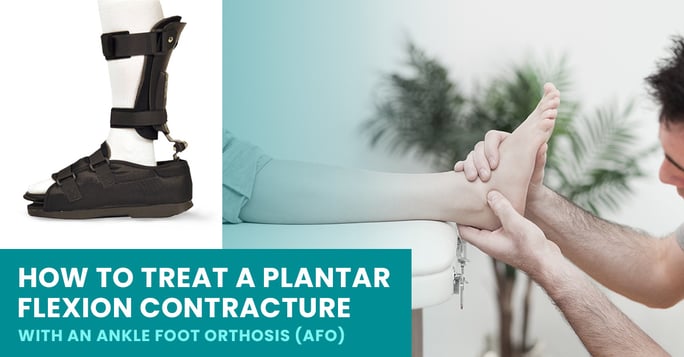
If your patient has difficulty bending their foot downward, walking, standing, or maintaining proper lower limb alignment, they may be experiencing a plantar flexion contracture (commonly known as foot drop). Plantar flexion is the movement of the foot away from the shin, and a plantar flexion contracture prevents a patient from performing this movement. This type of contracture makes everyday activities difficult, such as pressing a gas pedal or standing on tiptoes.
One of the most effective and common treatment options for a plantar flexion contracture is the use of a lower limb orthotic device, such as an ankle foot orthosis (AFO). In this article, we’ll explore the types of AFOs, how they help your patient, and what to consider as you prescribe these devices.
What Causes a Plantar Flexion Contracture?
A plantar flexion contracture may be the result of multiple circumstances, but some of the most common include a traumatic brain injury, spinal cord injury, stroke, prolonged immobilization, or a shortening of the calf muscles or Achilles tendon. Additionally, inherited disorders such as muscular dystrophy and underlying conditions of the brain and nerves (cerebral palsy, polio, stroke, severe osteoarthritis and rheumatoid arthritis) can lead to contractures.
If left untreated, plantar flexion contractures can lead to more serious gait abnormalities, increased risk of falls, pressure ulcers from improper foot positioning, joint stiffness, and muscle atrophy. Plus, physiological restrictions in normal activities like driving and playing sports have been shown to lead to a decreased quality of life for your patient.
As you form your patient’s treatment plan, consider how prescribing an AFO could contribute to faster healing, increased mobility, and comfortable lower limb alignment.
What is an Ankle Foot Orthosis (AFO)?
An AFO is a medical device designed to provide support and alignment to the ankle and foot. They’re widely used as a non-surgical treatment option to manage specific conditions and mobility issues of the lower limbs. AFOs can also be customized to address particular patient needs and anatomical variations. Orthotic treatment complements a patient’s overall therapeutic rehabilitation in a safe, productive, and comfortable manner.
The main uses of an ankle foot orthosis in treating a plantar flexion contracture are as follows:
- Maintaining Proper Foot Alignment: AFOs encourage a neutral foot position through a method of locking in mid-range to facilitate the correct alignment between the device and joint during application and removal.
- Facilitate Functional Ambulation: Ambulation is the act of walking or moving from one place to another. A tailored AFO addresses issues with a patient’s stability and gait.
- Reduce Risk of Related Complications: AFOs apply gentle corrective force to stretch the plantar flexor muscles over time. This, in turn, minimizes the risk of falls, pressure ulcers, joint stiffness, and muscle atrophy.
- Prevent Further Contracture Development: Any serious condition left untreated is bound to worsen. If started in the early stages of a plantar flexion contracture, an AFO can ensure your patient regains the full range of motion in the affected area.
What Types of AFOs are Available?
Now that you know what an AFO is, you might be wondering how to select the appropriate device for your patient. While Anatomical Concepts, Inc. has more than 10 types of AFOs to choose from, you may want to start with these devices as you decide which AFO to prescribe to target and treat a plantar flexion contracture:
- ABBY™ AFO Articulating Foot Orthosis: The ABBY™ AFO is a clinically proven multifunctional ambulatory articulated AFO for patients in the earliest stages of rehabilitation. It has a heat-moldable foot orthosis that delivers adjustable dorsiflexion (+ or - 20º) and plantar flexion (+ or - 40º), along with other capabilities.
- APU® AFO Articulating Ankle Foot Orthosis: The APU® AFO is clinically proven for effective ambulation and provides the practitioner a precise, simplified, and calibrated method of setting the optimal dorsiflexion to 20° or plantar flexion to 40° for the patient’s ankle/foot complex.
- DDA™ Articulating Ankle Foot Orthosis: The DDA™ (Dynamic Dorsi-Assist) Orthosis allows for the shortening and lengthening of the soft tissue to stimulate stretching of the gastrocnemius muscle that flexes your patient’s foot and knee. A series of posterior articulations allows for a virtually unrestricted range of plantar or dorsiflexion.
- Dual Action AFO Ankle Foot Orthosis: The Dual Action AFO offers the same features as our APU® AFO and the EV™ (Equino-Varus) AFO in one. Using the Dual Action Orthosis provides a precise and simplified method of setting the ankle/foot complex in the sagittal plane to accommodate ankle dorsiflexion to 20° and plantar flexion to 40°.
- RIBBY™ AFO Ankle Foot Orthosis: Lastly, the RIBBY™ AFO is a custom-fit, articulated orthotic brace that acts as an alternative, immediate way to manage your rehab patient’s orthotic care 24/7 from the initial onset of the accident that caused the plantar flexion contracture. This device combines ambulation, stability, and positive positioning into one AFO. If necessary, it also provides the option of locking out the ankle while continuing to provide static adjustability of dorsiflexion to 20° and plantar flexion to 40°, thus allowing for proper biomechanical gait parameters for a safer ambulatory environment.
What Should I Consider When Prescribing AFOs?
First of all, know that you won’t be doing it alone! When prescribing an AFO for your patient experiencing a plantar flexion contracture, you will work with an orthotist. An orthotist is a medical professional that specializes in the evaluation, biomechanical design, custom-fit, and follow-up of orthopedic bracing. Based on your prescription, an orthotist will conduct a clinical assessment of the patient’s affected ankle and foot. The orthotist will then recommend an orthotic brace that’s designed, customized, and fitted specifically for the patient, effectively addressing their unique needs and, ultimately, restoring function to the plantar flexor muscles.
When selecting an AFO for your patient with a plantar flexion contracture, consider the following factors:
- Severity of Contracture: The degree of your patient’s contracture will determine whether a rigid or dynamic AFO is appropriate.
- Mobility Level: A rigid AFO may be more suited for a patient with limited mobility, while an articulated AFO may better assist ambulatory patients.
- Comfort and Fit: The orthotic brace you select should be comfortable enough for your patient to regularly use it to maximize therapeutic benefits. Working with our expert team at Anatomical Concepts, Inc. will ensure that a professional orthotist will specifically fit the brace to your patient’s affected area and anatomical structure.
The Next Steps in Using an AFO to Treat Plantar Flexion Contractures
This type of lower limb condition can significantly impact your patient’s quality of life. Now that you’ve been briefed on the benefits of using an AFO to treat plantar flexion contractures in your patients, it’s time to take the next steps in restoring your patient’s function and mobility.
For more information on selecting the right AFO for your patients or to request a free quote, contact us today.
 330-757-3569
330-757-3569




